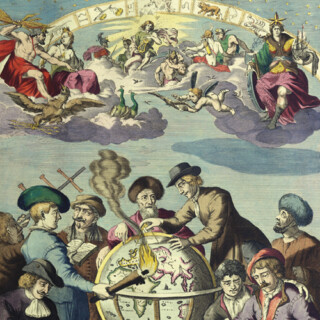Glossary of Terms for Collectors of Rare Maps, Atlases, Books, Globes and other related Scientific Objects.
Book binding leather from a calf hide or cattle hide; a commonly used material for leather binding (see also morocco, sheep, and vellum). Danish: Kalveskind A new leaf, often the title page, to which changes have been made, which is glued onto the narrow stub left by the removed leaf which has been excised. A tablet, for inscription (e.g. the titling of maps) or ornament. French: Cartouche The covers enclosing a book, usually made of thick cardboard, or a specially made case for a book or map. French: Emboîtage A catalogue raisonné is a documentary listing of all the works by an artist that are known at the time of compilation. A case or folding tray into which a book or map is laid, usually used in conjunction with a case into which the chemise is slipped (a slipcase). Danish: Omslag Colour printing from multiple impositions of lithographic stones or similar lithographic printing surfaces. Danish: Farvelitografi Clasps, like bosses and corner-pieces, were part of the protective armour of medieval (and post-medieval) bindings. A clasp, either of metal with a hinge, or with an intervening strip of leather or textile, on one board snapped into a catch on the other. Its object was to keep the book closed, relieving any strain on the joints from casual movement. In England and France the clasp was on the upper board, the catch on the lower; elsewhere in Europe the positions were reversed. Danish: Spænde Bookbinding material woven from cotton, linen, wool or synthetic fibres. Refers to the condition of a book or sheet of paper; the wrinkled, puckered, waving, or curling condition of a page or of the boards of a book, which is caused by non-uniform drying and shrinkage. If the cockled page is made of vellum, the condition is caused by humidity. In the case of paper or board, the condition is caused by heat and humidity. In the case of book covers, it can be caused by the use of the wrong type of adhesive or too much adhesive. Used in descriptive bibliography as the term that describes the non-binding portion of the book, verifying the proper sequence and completeness of pages & their gatherings (signatures). A statement occurring at the rear of a volume following the text, relating information about the printing history and physical aspects of the book; often includes name of printer, type of paper, typeface, size of edition, date of printing, etc. Early books often had a colophon instead of a title page imprint and modern private press or other examples of fine printing often use a colophon. Ruled lines forming a square border or frame on a binding, which is done in gilt or blind. Danish: Firkant, linje-indramninger i kvadrater eller rektangler Leaves that are physically attached, part of the same sheet. Counterproofs: In printmaking, impressions taken from a print or drawing by passing it through a press against a damp sheet of paper. The image appears in reverse. The binding of a book; i.e. cloth, calf, morocco, boards, wrappers, etc. The margins of the map or book have been trimmed, usually too close to, or into, the text or image. The most common type of book edges, trimmed even with a large binders knife prior to finishing the binding process (see also uncut, unopened, and deckle edges).
Glossary
C
Calf
Calf
Dutch: Kalfsleer
French: Veau
German: Kalbleder
Italian: Vitello
Spanish: Piel de becerro, becerrillo
Swedish: Kalvskinn
Cancel leaf
Cancel leaf
Cartouche
Cartouche
German: Kartusche
Case
Case
German: KassetteCatalogue raisonné
Catalogue raisonné
Chemise
Chemise
Dutch: Omslag, stofomslag
French: Chemise
German: Sammelmappe
Italian: Camicia
Spanish: Camisa
Swedish: Omslag
Chromolithography
Chromolithography
Dutch: Chromolithographie
French: Chromolithographie
German: Chromolithographie
Italian: Cromolitografia
Spanish: Cromo-litografía
Swedish: Färgliitografi
Clasp
Clasp
Dutch: Slot, klamp
French: Fermoirs
German: Schließe
Italian: Fermaglio
Spanish: Cierre
Swedish: Knäppe
Cloth
Cloth

Cockled
Cockled
Collation
Collation

Colophon
Colophon
Compartments
Compartments
Dutch: Verdeling in vierkanten of rechthoeken door lijnen
French: Compartiments ou caissons
German: Fileten
Italian: Riquadri
Spanish: Cuadrados
Swedish: Fyrkanter
Conjugate leaves
Conjugate leaves

Counterproof
Counterproof

Covers
Covers

Cropped
Cropped

Cut edges
Cut edges








